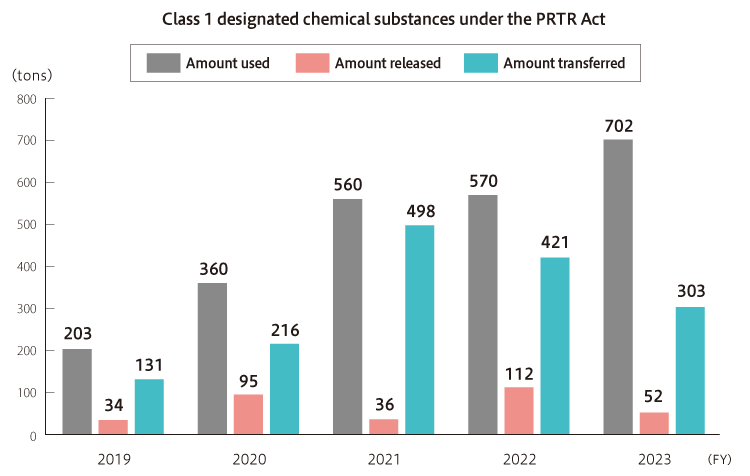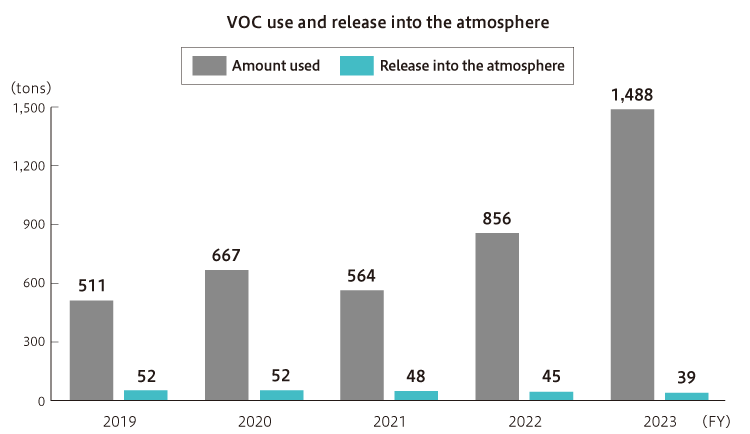Chemical Substances
Chemical Substance Management Initiatives
PRTR

Substances to be registered under the PRTR Act (Unit: kg)
| Substance name*1 | Amount used | Amount released | Amount transferred | |||
|---|---|---|---|---|---|---|
| Atmosphere | Drainage (public waters) |
Soil | Outside operating sites | Sewers | ||
| N-Methyl-2-pyrrolidone | 59,061 | 11 | 0 | 0 | 59,049 | 0 |
| Chloroform | 7,070 | 228 | 0 | 0 | 6,843 | 0 |
| Dichloromethane (methylene chloride) | 172,288 | 47,955 | 3 | 0 | 75,880 | 0 |
| Tetrahydrofuran | 233,608 | 3,383 | 0 | 0 | 107,177 | 0 |
| Toluene | 2,033 | 10 | 0 | 0 | 2,023 | 0 |
| Hexane | 6,682 | 516 | 0 | 0 | 6,166 | 0 |
| Heptane (n-heptane) | 1,103 | 11 | 0 | 0 | 1,092 | 0 |
| Carbon disulfide | 5,045 | 25 | 0 | 0 | 5,020 | 0 |
| N,N-Dimethylformamide | 33,337 | 54 | 0 | 0 | 2,091 | 0 |
| Pyridine | 6,175 | 0 | 0 | 0 | 4,949 | 0 |
| 4-Methyl-2-pentanone (methyl isobutyl ketone) | 168,443 | 190 | 0 | 0 | 27,805 | 0 |
| N,N-Dimethylacetamide | 3,061 | 0 | 0 | 0 | 3,061 | 0 |
| Tributylamine | 2,995 | 0 | 0 | 0 | 3,061 | 0 |
| Cyclohexane | 1,590 | 16 | 0 | 0 | 1,574 | 0 |
| G. total | 702,491 | 52,400 | 3 | 0 | 302,730 | 0 |

PCB
Polychlorinated biphenyls (PCBs) are synthetic, mainly oily chemical substances. It has been reported that when they accumulate in the bodies of living organisms, they cause various symptoms. PCBs released into the environment are a cause of great concern in terms of global-scale contamination because they are resistant to decomposition in the environment but soluble in fat, resulting in their tendency to accumulate in the bodies of living organisms through the food chain. PCBs were previously used in numerous items, such as condensers, transformers, and fluorescent light ballasts, and waste materials and equipment in use that contain PCBs must be strictly managed.
SHIONOGI appoints a manager to properly manage PCB-containing equipment for each organization or business site. Moreover, in accordance with the Act on Special Measures concerning Promotion of Proper Treatment of PCB Wastes (PCB Special Measures Act), we gradually proceeded with the proper disposal of PCB-containing equipment, and completed the disposal of all equipment containing high concentrations of PCBs installed in the buildings and premises we own by FY2022. We continue to take steps to complete the disposal of equipment containing low concentrations of PCBs by March 31, 2027, the deadline set forth in the PCB Special Measures Act.
Fluorocarbons
Environmental and safety consideration of chemical processes
SHIONOGI performs preliminary assessments of the safety of chemical substances and the danger of reactions and incompatibilities in the development stage of manufacturing and testing methods for pharmaceutical compounds and candidate compounds, and in the design stage of related equipment. We also examine manufacturing processes so as to enhance efficiency in terms of waste reduction, energy conservation, and the like in the manufacturing stage.
See the section “AMR” for more information on the environmental release management of antimicrobials.

